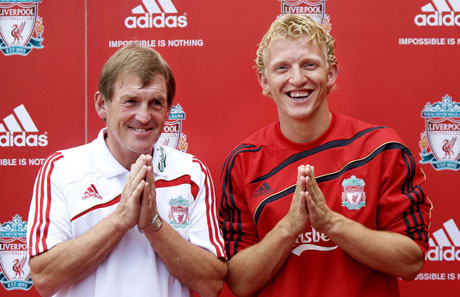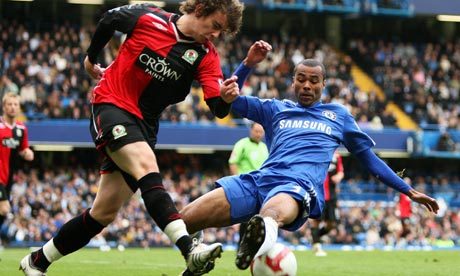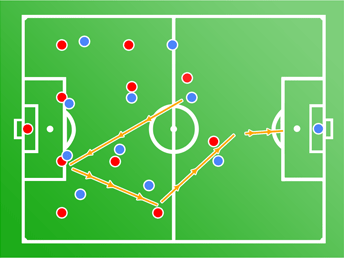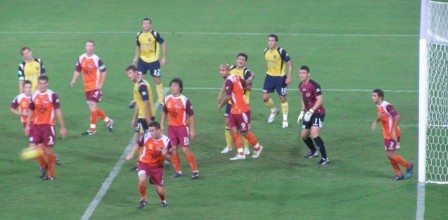-
Recent Articles
The Midfielder as Centerback
 Marcelo Biesla and Josep Guardiola are both managers who play a very high line with their respective sides and who both demand that all players be technically proficient with the ball. Part of playing...
Marcelo Biesla and Josep Guardiola are both managers who play a very high line with their respective sides and who both demand that all players be technically proficient with the ball. Part of playing...Understanding the 4-4-2 Diamond
DEFENCE Despite the fact that there are four ways to play a diamond formation on FM, the differences between them are few and usually subtle. As a starting point, one thing each of them do have...3 at the back and the 4-4-2 Diamond
 Last week Chelsea v Liverpool became the biggest tactical talking point of the season. Liverpool revived the the 3 man defence that Kenny debuted against Stoke. While with the introduction of Torres for £50m...
Last week Chelsea v Liverpool became the biggest tactical talking point of the season. Liverpool revived the the 3 man defence that Kenny debuted against Stoke. While with the introduction of Torres for £50m...How To Set Up A Back Four
 Last year, I wrote a guide about how to play a simple 4-4-2. One of the major components of that is the back four. In fact, most modern formations build upon four defenders; two full backs and two centre...
Last year, I wrote a guide about how to play a simple 4-4-2. One of the major components of that is the back four. In fact, most modern formations build upon four defenders; two full backs and two centre...Building Your Defence: Full Backs
 The modern full back is quickly becoming one of the most important players on the team sheet, infact even back in the days of Brian Clough, fat ed' argued that because of the space these players get in the final...
The modern full back is quickly becoming one of the most important players on the team sheet, infact even back in the days of Brian Clough, fat ed' argued that because of the space these players get in the final...
JOIN 12,748 READERS - SUBSCRIBE NOW TO OUR FOOTBALL MANAGER NEWSLETTER
Get the latest FM news & best community content delivered directly to your e-mail inbox!
Tactical Bible ’08: Analysing AI Tactic Systems
Written by: Richard Claydon
Category: Strategy
Posted on: March 11, 2007

March 11, 2007
Introduction
By the end of FM06’s playing life, I was able to chop and change my tactics as I pleased, showboating between 4-4-2 diamonds, Rafaesque 4-2-3-1s and versions of the Chelsea 4-3-3. It had become so easy to read the AI systems and employ a counter-system to defeat them that the game was losing all challenge. The AI couldn’t cope with my split mentality setup and all I had to do was ensure I had enough players back when playing an attacking AI and enough going forward against a defensive one.
FM06 was a revolution in terms of the AI tactic switching and attempting to comeback from 2 or 3 goals down. In the early days after 06’s release anger and frustration about the ‘comeback bug’ was widespread and intense. The resulting multi-tactic approach to FM, so common in today’s tactic design, was the only tactical solution to the AI changing tactics mid-match. Previously one tactic beats all was the name of the game. The transfer to the multi-tactic mentality was painful but far-ranging. I doubt anyone plays every match without some pre-game formation changes nowadays.
The AI hasn’t changed too much in terms of its propensity to tactic switch in 07. Any single AI side will happily run the gauntlet of tactics from the ultra-defensive 3-3-2-1-1 to an ultra-attacking 2-3-5 depending on match circumstance. In real terms there is no difference between this and the AI in 06. However, in 07 the type of tactic the AI is employing is much harder to pick.
Admittedly, none of us need telling that the 3-3-2-1-1 (4-5-1 in match commentary) is defensive, nor the 4-2-4 attacking and if pointing that out were the sole scope of this article I would be wasting my time typing it. What has changed in importance is understanding the mid-range mentality settings and being able to start a match with a strategy towards defeating them in mind.
Understanding AI Systems
The first step towards anticipating the AI strategy is the pre-game formation screen flicks up before the pre-match team talk. It can yield some very important clues as to what the AI wants to do. In England, most managers will play one of the following during the course of a normal game.
Flat 4-4-2
Flat 4-4-2 with short farrows on the wingers
Flat 4-4-2 with long farrows on the wingers
Flat 4-2-4
Each version of the tactic gets progressively more attacking and in 99% of cases it is safe to assume that the longer the arrows on the wingers the more adventurous the AI manager is. However, it is important to realise that starting formations relate to the style of play a manager prefers. In most cases, cautious managers will tend to keep their style of playing possession football and only change to ‘gung ho attack’ in desperate situations. More aggressive managers are likely to switch to attacking formations much earlier in the game.
The formation screen is the best place to build a good starting assumption, but other elements need to be added to complete the picture. Paying attention to in-game statistics and on field incidents becomes an important tool in deciding on whether the strategy you are using is the correct one or not. AI strategy can be decoded by paying attention to the following elements.
Attacking AI
With an attacking AI a key indicator is the large number of passes going forwards instead of sidewards or backwards. Players will not spend much time on the ball. The wingers will push forward and play level with the strikers. The central midfield will also push up although one MC/d tends to stay back and provide cover for the central defence. Pay careful attention to the opposition fullbacks. If they are pushing forward deep into your half and getting to the byline in support of the wingers then the AI is clearly attacking
Counter measure
Defensive strategies (weaker teams) or balanced strategies (stronger teams).
Possession AI:
This system is very difficult to play against. When attacking the AI builds up play slowly and doesn’t play too many risky forward passes. Build up play will consist of clinical through balls in the third half, occasional direct balls to breaking strikers hoofed up balls and crosses from deep positions. The AI managers who prefer this style will stick to this until very late in the match whether they be pushing for a goal or defending a lead. When top teams employ this style (e.g. Man U, Roma), they are very hard to counter with a defensive tactic. Best is to set up a well-balanced system to start taking the battle in midfield.
Counter measure:
defensive strategies (underdogs) or balanced (tweaked) strategies (medium and stronger teams).
Ultra-defensive AI
This system employs heavy time wasting. Watch for the increased amount of time players keep the ball before passing to a team mate. Most of the passes will aim to keep possession or clear the ball from danger and only a few look for counter opportunities. The most common forms of attack are balls hoofed up to a lone striker or very patient forward moves that can be finished by a dangerous quick pass or deep cross. There are many possible formations that employ this style: not only the classical 3-3-2-1-1 (which is the most obvious), also flat 4-4-2s, defensive 4-4-2s (2 DMCs, often referred as 4-2-2-2), 4-1-4-1s, some diamonds and the French and German 4-2-1-2-1s.
Counter measure:
overloading strategies, after most attacking versions (plus unticking counter) have failed
Ultra attacking AI
This strategy usually plays as a 4-2-4 but occasional more idiosyncratic formations are possible (2-3-5). The AI employs next to no time wasting. Forward runs are high on almost every position, including the previously cover-minded MC/d, which often results in an overloading of the opposition’s defence. Only the two centre-backs stay back. There will be a high number of long shots from any half-promising midfield position. There is also the very dangerous option of long balls out of the defence to a fast breaking front four which misses out both sets of midfield. At times it will feel like playing against 8 forwards.
Low ranked teams often play the 4-2-4 with a possession approach, keeping hold of the ball until the forwards break and then trying to hit them with a long ball from defence.
Counter measure:
kill game/shut up shop strategies (all teams)
Defensive AI:
This is sometimes difficult to differentiate from the possession AI. Most of the observations on a possession AI remain, but with careful scrutiny you will see the passing is more cautious and the time wasting slightly higher. The most obvious change from the possession system is the very strong positional constancy of any defensive player. The back four will stay back at all times and are almost always covered by the DMCs. If the AI is using two strikers, you will see one of them continuously dropping very deep to pick up the ball and/or help out the defence. The other striker constantly looks to beat your offside line which can be very clinical and dangerous. The midfield will only get forward in support on occasional instances when the chance is most definitely on.
Counter measure
balanced and attacking strategies, sometimes overloading for top 4 teams
Continental and Multi-Strata Formations
More problems arise with non-standard managers (two that readily come to mind are Mourinho and Allardyce) who play 4-3-3s, wingless’4-1-3-2 and 4-5-1s. Although harder to pick, they still offer clues to their intentions. Are the wing backs or wingers farrowed? Does the formation employ a pure DM, a flat three in the centre or an AMC? A good example is Rapid Bucharesti which plays a 3-5-2 with an AM when attacking, but a 3-5-2 with DM when defending.
Many Spanish teams use the 4-2-3-1 for a cautious game before switching to a 4-4-2 if they need to score. The most difficult formations to successfully pick are diamonds, the Cappello 4-2-2-2 and some 4-5-1/4-3-3 hybrid formations. They often don’t change during the game and adapt between attacking, defensive or possession mindsets entirely through mentality and forward runs.
Expected AI Changes
Since FM06 users have become accustomed to change formations to counter the AI mentality and its tactical switches. If done well it can lead to a fantastic performance. However, badly or hastily made decisions can prove disastrous and are often enough punished by conceding immediately after switching tactics and eventually losing the game.
Don’t change to a more aggressive tactic immediately after conceding, especially away. Once the AI team takes the lead, unless it comes late in the match, it will generally look for a second goal. If the AI is playing at home the extra crowd input from the first goal will give the AI team a boost and an instant change to a more aggressive formation will allow them more holes to exploit.
It is hard to determine the AI mentality by watching key highlights only, but as that is the preferred mode of playing for most the occasional hints in the match commentary offers some help. There are some other in-game strategies you can use while watching the match highlights or more. As you can predict with relative certainty what the AI will do in certain situations, based on the rank of both teams, venue, who scores, etc you should be able to switch strategy with some success. Less experienced players will definitely gain an advantage from using extended highlights until they have gained more experience. For key games they are almost a must, no matter how long you have been playing.
For example, after a goal against a team that the AI thinks it can beat, the AI will nearly always go more attacking or keep to an already aggressive style in an attempt to grab a second with the crowd behind them and their tails up and kill off the game. Similarly, after conceding or grabbing a lucky lead when the AI thinks it will lose, the AI usually shuts up shop and is content to try and pick off the team as they commit men forward in an attempt to get back into the game. Nevertheless, some teams shut up shop after conceding in first half, but will try to come back in second. If they go down by two goals some AI teams will still try to get back into the game whereas others will shut up shop to try and prevent embarrassment . Paying attention to the AI formation ater a second goal is vital in understanding its mentality. Underdogs will shut up shop in the second half after starting defensive if still defending a draw. Knowing what the AI usually does helps you see better what’s going on.
Definition of Counter Measures
SUS/Kill Game
Very defensive, time wasting approach against 4-2-4s etc. during last 15-20 minutes of a game.
Defensive
Either ‘interdiction’, very defensive and slightly destructive or ‘possession’, defensive but trying to control the game from the back
Balanced
Playing higher up the pitch, controlling the game from a solid defence, defensive supporting midfield, but looking actively for attacking/counter options
Attack-Away/Attack
Clear effort to dominate the game all over the pitch, create and convert chances in high numbers
Overloading
Hyper-attacking formations with large numbers of attacking players or very massive concentration of attacking players.
Knowing You Have ‘Got It Right’
The key indicators that the user team is outperforming the AI team are the passing percentage and possession statistics. Although they don’t stabilise until circa the 10th minute, if you are not losing by then they will offer an excellent analysis of how well your team is performing.
At home, the user will want to see an eight per cent or greater advantage in possession (>54%) and a ten per cent or greater advantage in pass percentage.
Away the user will want to see a two to six per cent advantage in possession (51-53%) and a five to ten per cent advantage in pass percentage.
This is obviously variable when playing teams outside your division in cup games but it is a good rule of thumb when checking to see you have picked the right version. Also it’s an ideal rather than absolute and a user could well be happy with 52% possession at home with circa 75% passing against an Ai pass percentage of circa 55%.
These stats can be turned on their heads in the last 15 minutes if the AI switches to an ultra-attacking or defensive system, but until then it is a good method to verify your tactical choice. Goals are a better method but unfortunately a lot less frequent than passes!
Possession stats should be related to the average possession performance. They are likely to differ for teams with tactics that aim at less possession (counter, high tempo, long passing, Target Man Supply etc.). For these teams shot ratios and SOT ratios are more relevant, as are as action zones.
Tactical Bible Credits
Thanks to the following for their contributions to this topic: The next Diaby, Millie, thegooner, wwfan
About The Author: Richard Claydon
Tactical theory has evolved massively down the years, from Diablo-style beat-’em-alls through Cleon’s era to the present day systems inspired by wwfan’s theories. Richard is considered to be the authority on FM tactics, and was approached by Sports Interactive to help write the new tactical interface in Football Manager Live and Football Manager 2010.
Download Our Tactical Theorems '10 eBook Absolutely Free

Presenting the most comprehensive tactic design and match strategy guide to the Football Manager series ever created!
Written by FM match engine beta testers, it's 60+ pages of easy-to-read concepts and ideologies for getting your team playing exactly how you want each match! It's been downloaded over 100,000+ times to date!
Find out more information about our tactical eBook
and download Tactical Theorems '10 right now!
Written by FM match engine beta testers, it's 60+ pages of easy-to-read concepts and ideologies for getting your team playing exactly how you want each match! It's been downloaded over 100,000+ times to date!
and download Tactical Theorems '10 right now!




